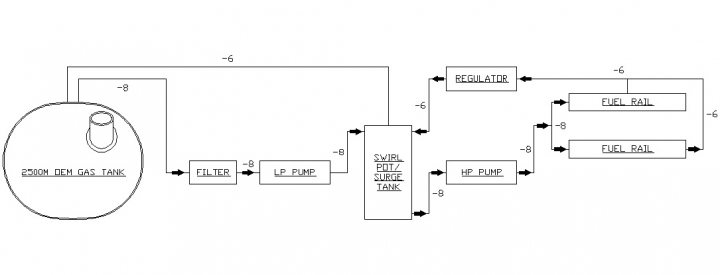slowM
Nuclear
- Oct 25, 2011
- 11
Hello all,
All of the items listed with a part number, have been purchased. This still leaves me with a good number of questions.
Fuel System:
Fuel Pickup (In-Tank) ......................... Paxton, part # 8002122
Fuel Filter: .................................. Paxton, part # 8001689
LP Pump: .........?
Surge Tank: .....?
HP Pump: ...................................... Paxton 1000 HP, part # 8001688
Filter Element: spec? ... part # ?
Injectors...................................... Bosch, part #0280155968, type - EV1 "Green Giant" with connectors, Impedance - 11-18 ohms, Flow Rate - 42 lbs/hr, 440cc,
Fuel Rails: .....................5/8" ID billet Paxton, part # 5007026-2
Fuel pressure Regulator: ........... Adjustable Paxton, part # 8001690
This is essentially what I have in mind: (or see attachment)
Pickup (8AN out) → Filter → Low Pressure Pump → Surge Tank/Swirl Pot ^ top → Return, bottom → High Pressure Pump → Rails → Pressure Regulator → Return.
Having thought this through, I'm left with plenty of questions:
What filter element (or filtration size in microns) should I use?
When feeding the high pressure pump from an external surge tank, I suspect that the flow capacity of the LP pump should slightly exceed the calculated maximum fuel usage, at any point in the rev range. Is there a standard correlation/factor, or a ratio to HP, that determines the delivery volume of the LP pump?
I will probably run an Aeromotive speed controller*, for the HP pump. Would I want to speed control the LP pump in a similar way, to maintain some form of parity?
For what reason would one want a filter between the pumps? I have read about one design where there was a filter after the LP pump, and another, after the HP pump. What is the benefit of this design?
What factors are usually considered, for sizing the surge tank/swirl pot? I have read, that the base line should be the time it would take to negotiate the longest corner, multiplied by the maximum flow rate of the injectors. I'll avoid the skidpad.
I like the Walbro pick-ups, but am not certain they will fit in the tank. Do any of you know what diameter they are? The dimension I am finding on Amazon is +5”, but that could be for the box. I seroiously doubt that I can fit anything much over 1.75” diameter. Is there a similar product, that meets my diminutive sizing restrictions?
Am I making any errors, that I'm not seeing?
*
Many thanks, in advance, to any and all who can give me a little more insight, and best regards,
B.
All of the items listed with a part number, have been purchased. This still leaves me with a good number of questions.
Fuel System:
Fuel Pickup (In-Tank) ......................... Paxton, part # 8002122
Fuel Filter: .................................. Paxton, part # 8001689
LP Pump: .........?
Surge Tank: .....?
HP Pump: ...................................... Paxton 1000 HP, part # 8001688
Filter Element: spec? ... part # ?
Injectors...................................... Bosch, part #0280155968, type - EV1 "Green Giant" with connectors, Impedance - 11-18 ohms, Flow Rate - 42 lbs/hr, 440cc,
Fuel Rails: .....................5/8" ID billet Paxton, part # 5007026-2
Fuel pressure Regulator: ........... Adjustable Paxton, part # 8001690
This is essentially what I have in mind: (or see attachment)
Pickup (8AN out) → Filter → Low Pressure Pump → Surge Tank/Swirl Pot ^ top → Return, bottom → High Pressure Pump → Rails → Pressure Regulator → Return.
Having thought this through, I'm left with plenty of questions:
What filter element (or filtration size in microns) should I use?
When feeding the high pressure pump from an external surge tank, I suspect that the flow capacity of the LP pump should slightly exceed the calculated maximum fuel usage, at any point in the rev range. Is there a standard correlation/factor, or a ratio to HP, that determines the delivery volume of the LP pump?
I will probably run an Aeromotive speed controller*, for the HP pump. Would I want to speed control the LP pump in a similar way, to maintain some form of parity?
For what reason would one want a filter between the pumps? I have read about one design where there was a filter after the LP pump, and another, after the HP pump. What is the benefit of this design?
What factors are usually considered, for sizing the surge tank/swirl pot? I have read, that the base line should be the time it would take to negotiate the longest corner, multiplied by the maximum flow rate of the injectors. I'll avoid the skidpad.
I like the Walbro pick-ups, but am not certain they will fit in the tank. Do any of you know what diameter they are? The dimension I am finding on Amazon is +5”, but that could be for the box. I seroiously doubt that I can fit anything much over 1.75” diameter. Is there a similar product, that meets my diminutive sizing restrictions?
Am I making any errors, that I'm not seeing?
*
Many thanks, in advance, to any and all who can give me a little more insight, and best regards,
B.

